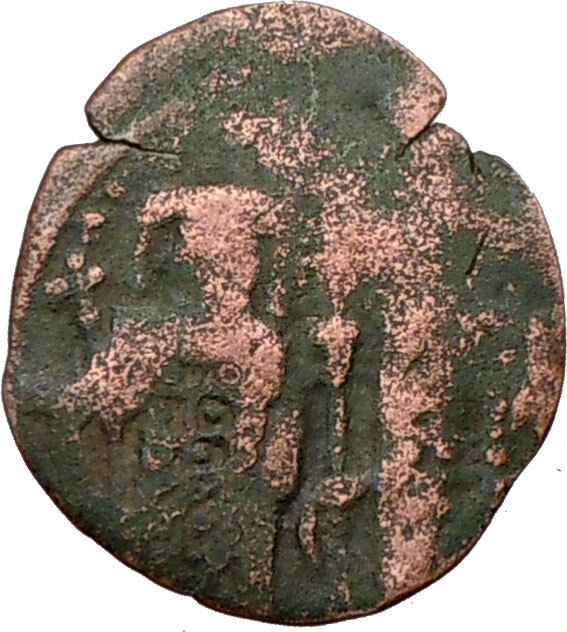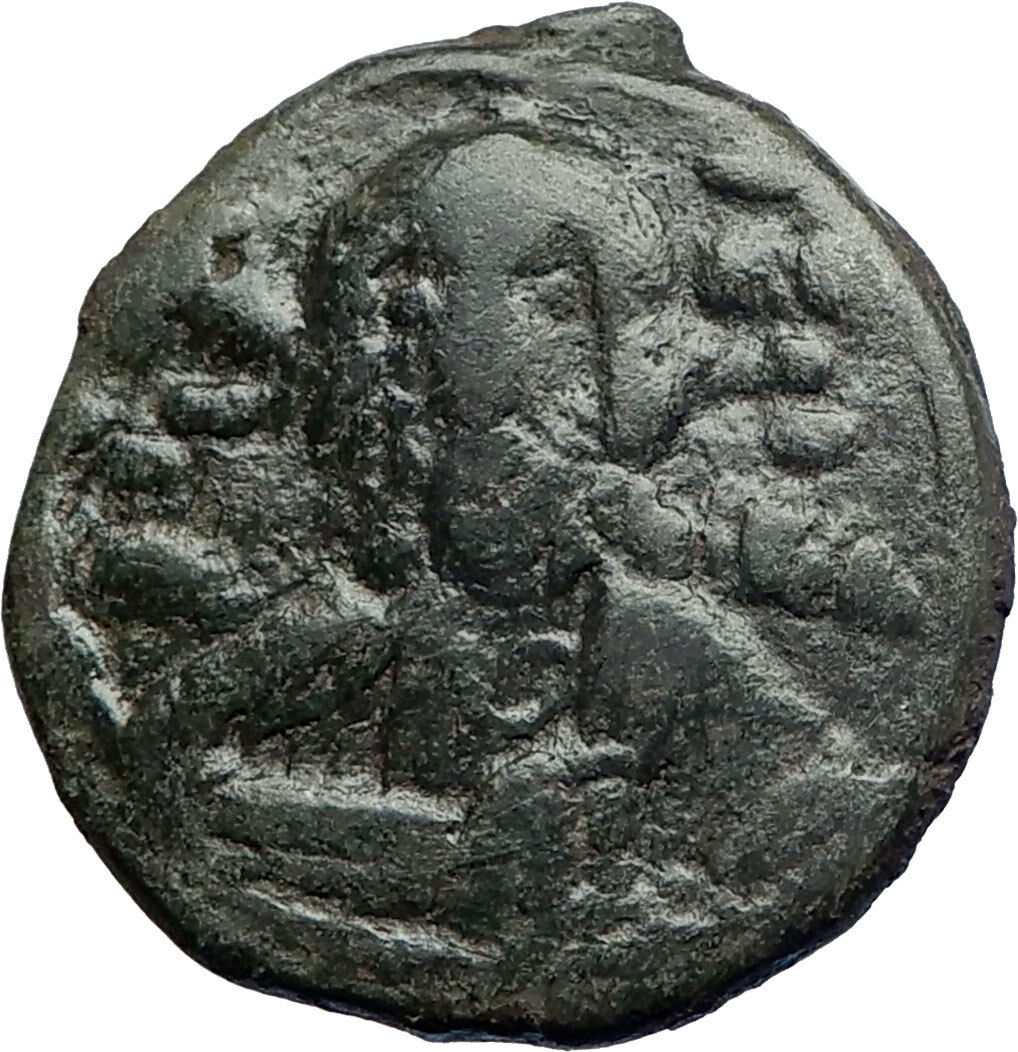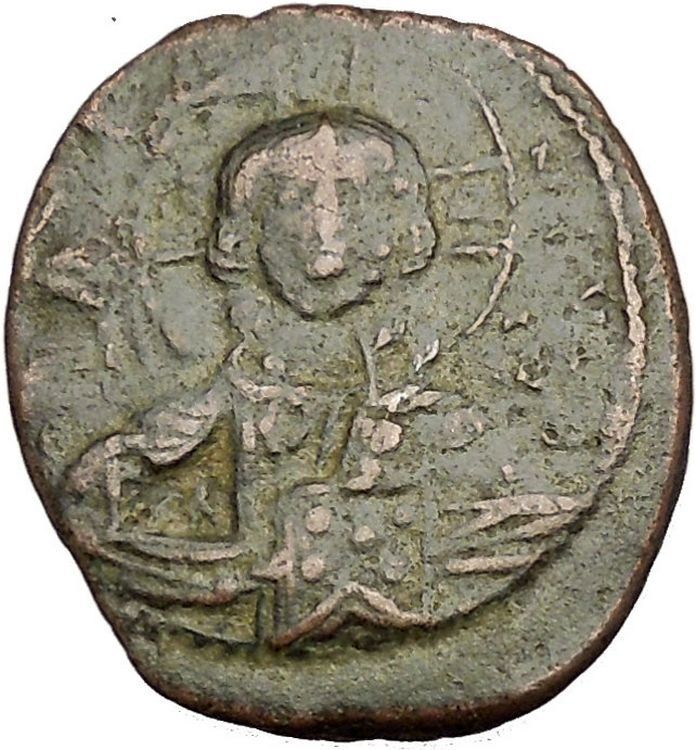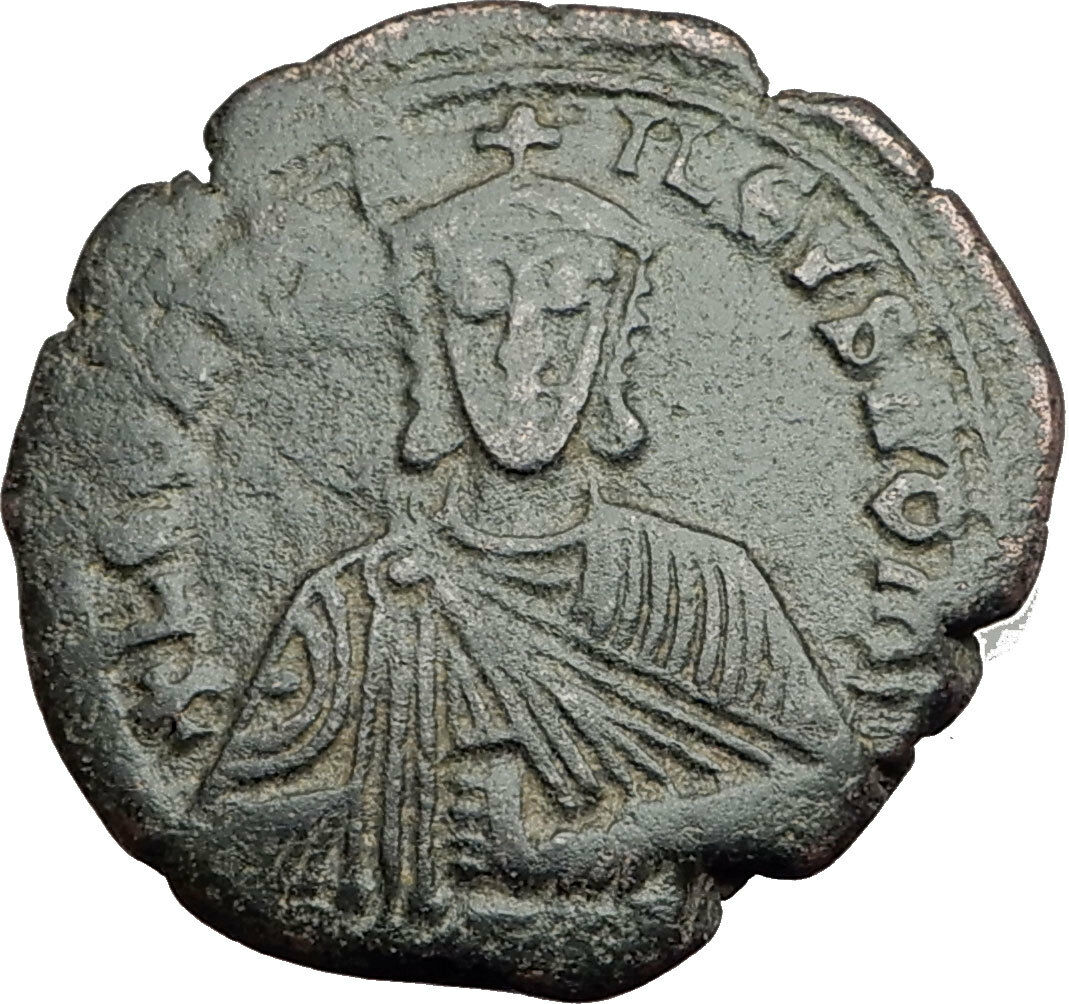|
Byzantine Empire
Constantine VI and Irene – Reigned 780-797 A.D.
Silver Miliaresion 20mm (1.59 grams) Constantinople mint, struck circa 780-797 A.D.
Reference: Sear 1595; DOC 4a.
IҺSЧS XRISTЧS ҺICA Cross potent set on three steps.
COҺS/TAҺTInO/S S IRInIЄ/ C ΘЄЧ bA/SILIS in five lines.
You are bidding on the exact item pictured, provided with a Certificate of Authenticity and Lifetime Guarantee of Authenticity.
Irene of Athens (Greek: Εἰρήνη ἡ Ἀθηναία; c. 752 – 9 August 803 AD), also known as Irene Sarantapechaina (Greek: Εἰρήνη Σαρανταπήχαινα), was Byzantine empress consort by marriage to Leo IV from 775 to 780, Byzantine regent during the minority of her son Constantine VI from 780 until 790, and finally ruling Byzantine (Eastern Roman) empress from 797 to 802. She is best known for ending Iconoclasm.
Early life
Irene was related to the noble Greek Sarantapechos family of Athens. Although she was an orphan, her uncle or cousin Constantine Sarantapechos was a patrician and was possibly general (Greek: strategos) of the theme of Hellas at the end of the 8th century.
Empress consort
She was brought to Constantinople by Emperor Constantine V on 1 November 768 and was married to his son Leo IV on 17 December. Although she appears to have come from a noble family, there is no clear reason why she would have been chosen as Leo’s bride, leading some scholars to speculate that she was selected in a bride-show, in which eligible young women were paraded before the bridegroom until one was finally selected.
On 14 January 771, Irene gave birth to a son, the future Constantine VI. When Constantine V died in September 775, Leo succeeded to the throne at the age of twenty-five years. An unnamed female relative of Irene was married to the Bulgar ruler Telerig in 776. Irene also had a nephew.
Leo, though an iconoclast, pursued a policy of moderation towards iconodules, but his policies became much harsher in August 780, when a number of courtiers were punished for venerating icons. According to tradition, he discovered icons concealed among Irene’s possessions and refused to share the marriage bed with her thereafter. Irene had only one child, Constantine VI.
Regent
When Leo died on 8 September 780, Irene became regent for their nine-year-old son Constantine.
Irene was almost immediately confronted with a conspiracy that tried to raise Caesar Nikephoros, a half-brother of Leo IV, to the throne. To overcome this challenge, she had Nikephoros and his co-conspirators ordained as priests, a status which disqualified them from ruling.
As early as 781, Irene began to seek a closer relationship with the Carolingian dynasty and the Papacy in Rome. She negotiated a marriage between her son Constantine and Rotrude, a daughter of Charlemagne by his third wife Hildegard. During this time Charlemagne was at war with the Saxons, and would later become the new king of the Franks. Irene went as far as to send an official to instruct the Frankish princess in Greek; however, Irene herself broke off the engagement in 787, against her son’s wishes.
Irene next had to subdue a rebellion led by Elpidius, the strategos of Sicily. Irene sent a fleet, which succeeded in defeating the Sicilians. Elpidius fled to Africa, where he defected to the Abbasid Caliphate. After the success of Constantine V’s general, Michael Lachanodrakon, who foiled an Abbasid attack on the eastern frontiers, a huge Abbasid army under Harun al-Rashid invaded Anatolia in summer 782. The strategos of the Bucellarian Theme, Tatzates, defected to the Abbasids, and Irene had to agree to pay an annual tribute of 70,000 or 90,000 dinars to the Abbasids for a three-year truce, to give them 10,000 silk garments, and to provide them with guides, provisions, and access to markets during their withdrawal.
Ending Iconoclasm
Irene’s most notable act was the restoration of the veneration of icons (images of Christ or the saints). Having chosen Tarasios, one of her partisans and her former secretary, as Patriarch of Constantinople in 784, she summoned two church councils. The first of these, held in 786 at Constantinople, was frustrated by the opposition of the iconoclast soldiers. The second, convened at Nicaea in 787, formally revived the veneration of icons and reunited the Eastern church with that of Rome.[2] (See Seventh Ecumenical Council.)
While this greatly improved relations with the Papacy, it did not prevent the outbreak of a war with the Franks, who took over Istria and Benevento in 788. In spite of these reverses, Irene’s military efforts met with some success: in 782 her favoured courtier Staurakios subdued the Slavs of the Balkans and laid the foundations of Byzantine expansion and re-Hellenization in the area. Nevertheless, Irene was constantly harried by the Abbasids, and in 782 and 798 had to accept the terms of the respective Caliphs Al-Mahdi and Harun al-Rashid.
Empress Regnant
As Constantine approached maturity he began to grow restless under her autocratic sway. An attempt to free himself by force was met and crushed by the Empress, who demanded that the oath of fidelity should thenceforward be taken in her name alone. The discontent which this occasioned swelled in 790 into open resistance, and the soldiers, headed by the army of the Armeniacs, formally proclaimed Constantine VI as the sole ruler.
A hollow semblance of friendship was maintained between Constantine and Irene, whose title of empress was confirmed in 792; but the rival factions remained, and in 797 Irene, by cunning intrigues with the bishops and courtiers, organized a conspiracy on her own behalf. Constantine could only flee for aid to the provinces, but even there participants in the plot surrounded him. Seized by his attendants on the Asiatic shore of the Bosphorus, Constantine was carried back to the palace at Constantinople. His eyes were gouged out, and he died from his wounds several days later. A solar eclipse and darkness lasting 17 days were attributed to the horror of Heaven.
Although it is often asserted that, as monarch, Irene called herself “basileus” (βασιλεύς), ’emperor’, rather than “basilissa” (βασίλισσα), ’empress’, in fact there are only three instances where it is known that she used the title “basileus”: two legal documents in which she signed herself as “Emperor of the Romans” and a gold coin of hers found in Sicily bearing the title of “basileus”. In relation to the coin, the lettering is of poor quality and the attribution to Irene may be problematic. She used the title “basilissa” in all other documents, coins, and seals.
Relationship with the Carolingian Empire
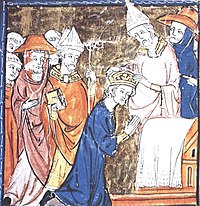
Refusing to recognize Irene’s reign, Pope Leo III crowned Charlemagne as Holy Roman Emperor.
Irene’s unprecedented position as an Empress ruling in her own right was emphasized by the coincidental rise of the Carolingian Empire in Western Europe, which rivaled Irene’s Byzantium in size and power. Charlemagne invaded Italy early on in his reign, annexing the Lombard kingdom of Italy. He also campaigned against the Saxon tribes in northern Germany for more than thirty years, annexing their territory and compelling them to convert to Christianity, and defeated the Avars in Central Europe. In the Iberian Peninsula, Charlemagne’s expedition against al-Andalus led to the creation of a buffer zone between Francia and the Islamic world called the “Spanish March”. Charlemagne also increasingly modelled his rule after Roman Emperors by sponsoring enormous construction programs, exemplified by the building of his favourite residence at Aachen (in modern-day Germany), standardizing weights and measures and supporting intellectual and artistic endeavors in the Carolingian renaissance. Moreover, Charlemagne issued laws called “capitularies” in the style of a Roman Emperor.
Charlemagne was crowned Emperor by Pope Leo III on Christmas Day, 800. The clergy and nobles attending the ceremony proclaimed Charlemagne as “Augustus”. In support of Charlemagne’s coronation, some argued that the Imperial position was actually vacant, deeming a woman unfit to be Emperor. However, Charlemagne made no claim to the Eastern Roman Empire. Whether he actually desired a coronation at all, remains controversial – his biographer Einhard related that Charlemagne had been surprised by the Pope – but the Eastern Empire felt its role as the sole Roman Empire threatened and began to emphasize its superiority and its Roman identity. Relations between the two Empires remained difficult. Irene is said to have endeavoured a marriage alliance between herself and Charlemagne, but according to Theophanes the Confessor, who alone mentions it, the scheme was frustrated by Aetios, one of her favourites.
Deposition and death
In 802 the patricians conspired against her and placed Nikephoros, the minister of finance (logothetēs tou genikou), on the throne. Irene was exiled to Lesbos and forced to support herself by spinning wool. She died the following year.
Legacy
A female relative of Irene, Theophano, was chosen in 807 by Emperor Nikephoros I as the bride of his son and heir Staurakios.
Irene’s zeal in restoring the icons and monasteries made Theodore the Studite praise her as a saint of the Eastern Orthodox Church, but she was not canonized. Claims about her supposed canonization are mainly from Western sources. Such claims are not supported by the Menaion (the official liturgical book providing the propers of the saints of the Orthodox Church), the “Lives of Saints” by Nikodemos the Hagiorite, or any other relative book of the Orthodox Church.
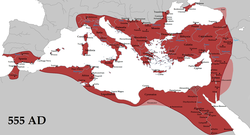 The Byzantine Empire, or Eastern Roman Empire, was the predominantly Greek-speaking eastern half continuation and remainder of the Roman Empire during Late Antiquity and the Middle Ages. Its capital city was Constantinople (modern-day Istanbul), originally founded as Byzantium. It survived the fragmentation and fall of the Western Roman Empire in the 5th century AD and continued to exist for an additional thousand years until it fell to the Ottoman Turks in 1453. During most of its existence, the empire was the most powerful economic, cultural, and military force in Europe. Both “Byzantine Empire” and “Eastern Roman Empire” are historiographical terms created after the end of the realm; its citizens continued to refer to their empire as the Roman Empire (Ancient Greek: Βασιλεία Ῥωμαίων, tr. Basileia Rhōmaiōn; Latin: Imperium Romanum), or Romania (Ῥωμανία), and to themselves as “Romans”. The Byzantine Empire, or Eastern Roman Empire, was the predominantly Greek-speaking eastern half continuation and remainder of the Roman Empire during Late Antiquity and the Middle Ages. Its capital city was Constantinople (modern-day Istanbul), originally founded as Byzantium. It survived the fragmentation and fall of the Western Roman Empire in the 5th century AD and continued to exist for an additional thousand years until it fell to the Ottoman Turks in 1453. During most of its existence, the empire was the most powerful economic, cultural, and military force in Europe. Both “Byzantine Empire” and “Eastern Roman Empire” are historiographical terms created after the end of the realm; its citizens continued to refer to their empire as the Roman Empire (Ancient Greek: Βασιλεία Ῥωμαίων, tr. Basileia Rhōmaiōn; Latin: Imperium Romanum), or Romania (Ῥωμανία), and to themselves as “Romans”.
Several events from the 4th to 6th centuries mark the transitional period during which the Roman Empire’s east and west divided. In 285, the emperor Diocletian (r. 284-305) partitioned the Roman Empire’s administration into eastern and western halves. Between 324 and 330, Constantine I (r. 306-337) transferred the main capital from Rome to Byzantium, later known as Constantinople (“City of Constantine”) and Nova Roma (“New Rome”). Under Theodosius I (r. 379-395), Christianity became the Empire’s official state religion and others such as Roman polytheism were proscribed. And finally, under the reign of Heraclius (r. 610-641), the Empire’s military and administration were restructured and adopted Greek for official use instead of Latin. Thus, although it continued the Roman state and maintained Roman state traditions, modern historians distinguish Byzantium from ancient Rome insofar as it was oriented towards Greek rather than Latin culture, and characterised by Orthodox Christianity rather than Roman polytheism.
The borders of the Empire evolved significantly over its existence, as it went through several cycles of decline and recovery. During the reign of Justinian I (r. 527-565), the Empire reached its greatest extent after reconquering much of the historically Roman western Mediterranean coast, including north Africa, Italy, and Rome itself, which it held for two more centuries. During the reign of Maurice (r. 582-602), the Empire’s eastern frontier was expanded and the north stabilised. However, his assassination caused a two-decade-long war with Sassanid Persia which exhausted the Empire’s resources and contributed to major territorial losses during the Muslim conquests of the 7th century. In a matter of years the Empire lost its richest provinces, Egypt and Syria, to the Arabs.
During the Macedonian dynasty (10th-11th centuries), the Empire again expanded and experienced a two-century long renaissance, which came to an end with the loss of much of Asia Minor to the Seljuk Turks after the Battle of Manzikert in 1071. This battle opened the way for the Turks to settle in Anatolia as a homeland.
The final centuries of the Empire exhibited a general trend of decline. It struggled to recover during the 12th century, but was delivered a mortal blow during the Fourth Crusade, when Constantinople was sacked and the Empire dissolved and divided into competing Byzantine Greek and Latin realms. Despite the eventual recovery of Constantinople and re-establishment of the Empire in 1261, Byzantium remained only one of several small rival states in the area for the final two centuries of its existence. Its remaining territories were progressively annexed by the Ottomans over the 15th century. The Fall of Constantinople to the Ottoman Empire in 1453 finally ended the Byzantine Empire.
|





 The Byzantine Empire, or Eastern Roman Empire, was the predominantly Greek-speaking eastern half continuation and remainder of the Roman Empire during Late Antiquity and the Middle Ages. Its capital city was Constantinople (modern-day Istanbul), originally founded as Byzantium. It survived the fragmentation and fall of the Western Roman Empire in the 5th century AD and continued to exist for an additional thousand years until it fell to the Ottoman Turks in 1453. During most of its existence, the empire was the most powerful economic, cultural, and military force in Europe. Both “Byzantine Empire” and “Eastern Roman Empire” are historiographical terms created after the end of the realm; its citizens continued to refer to their empire as the Roman Empire (Ancient Greek: Βασιλεία Ῥωμαίων, tr. Basileia Rhōmaiōn; Latin: Imperium Romanum), or Romania (Ῥωμανία), and to themselves as “Romans”.
The Byzantine Empire, or Eastern Roman Empire, was the predominantly Greek-speaking eastern half continuation and remainder of the Roman Empire during Late Antiquity and the Middle Ages. Its capital city was Constantinople (modern-day Istanbul), originally founded as Byzantium. It survived the fragmentation and fall of the Western Roman Empire in the 5th century AD and continued to exist for an additional thousand years until it fell to the Ottoman Turks in 1453. During most of its existence, the empire was the most powerful economic, cultural, and military force in Europe. Both “Byzantine Empire” and “Eastern Roman Empire” are historiographical terms created after the end of the realm; its citizens continued to refer to their empire as the Roman Empire (Ancient Greek: Βασιλεία Ῥωμαίων, tr. Basileia Rhōmaiōn; Latin: Imperium Romanum), or Romania (Ῥωμανία), and to themselves as “Romans”.

